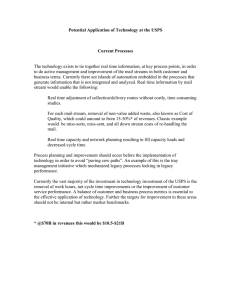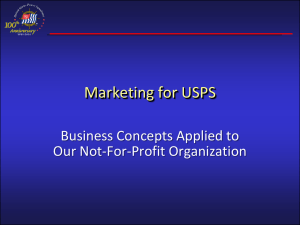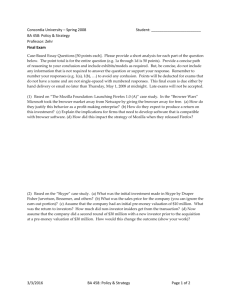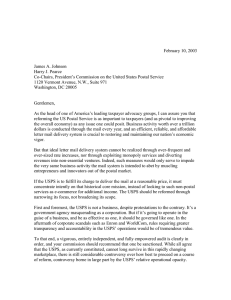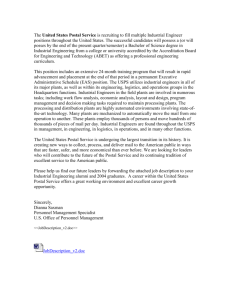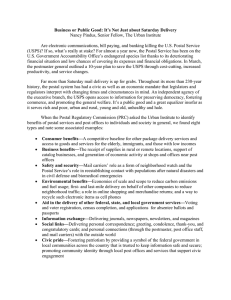Submitted By: Lockheed Martin Distribution Technologies 1801 State Route 17C
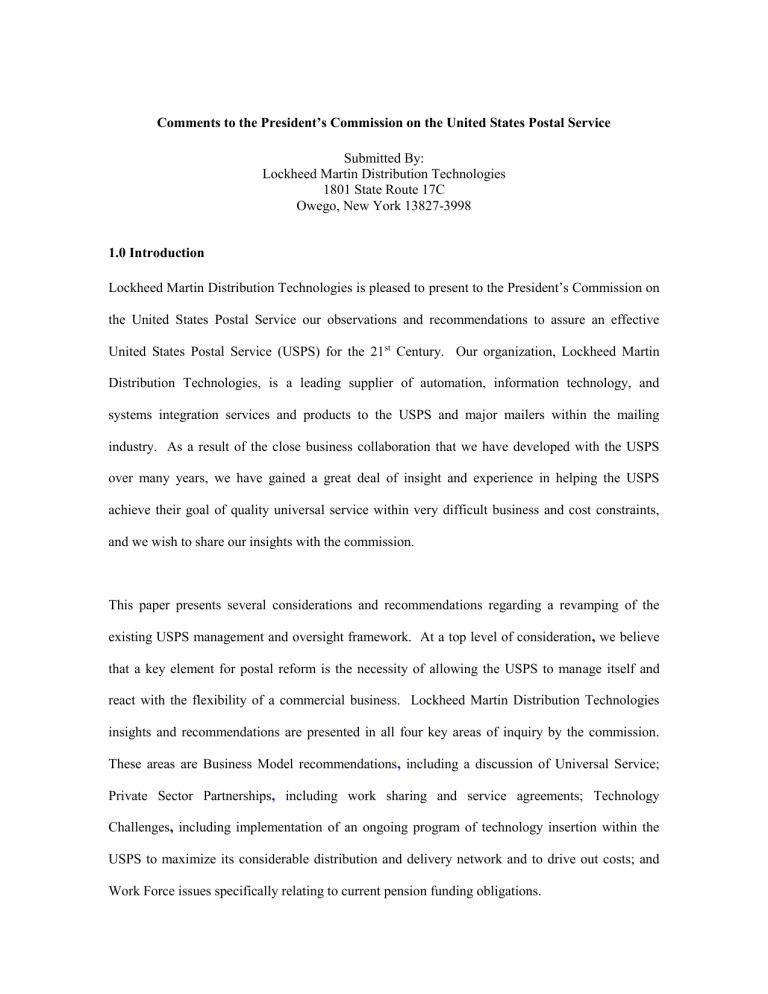
Comments to the President’s Commission on the United States Postal Service
Submitted By:
Lockheed Martin Distribution Technologies
1801 State Route 17C
Owego, New York 13827-3998
1.0 Introduction
Lockheed Martin Distribution Technologies is pleased to present to the President’s Commission on the United States Postal Service our observations and recommendations to assure an effective
United States Postal Service (USPS) for the 21 st Century. Our organization, Lockheed Martin
Distribution Technologies, is a leading supplier of automation, information technology, and systems integration services and products to the USPS and major mailers within the mailing industry. As a result of the close business collaboration that we have developed with the USPS over many years, we have gained a great deal of insight and experience in helping the USPS achieve their goal of quality universal service within very difficult business and cost constraints, and we wish to share our insights with the commission.
This paper presents several considerations and recommendations regarding a revamping of the existing USPS management and oversight framework. At a top level of consideration , we believe that a key element for postal reform is the necessity of allowing the USPS to manage itself and react with the flexibility of a commercial business. Lockheed Martin Distribution Technologies insights and recommendations are presented in all four key areas of inquiry by the commission.
These areas are Business Model recommendations , including a discussion of Universal Service;
Private Sector Partnerships , including work sharing and service agreements; Technology
Challenges , including implementation of an ongoing program of technology insertion within the
USPS to maximize its considerable distribution and delivery network and to drive out costs; and
Work Force issues specifically relating to current pension funding obligations.
We at Lockheed Martin wish to thank the Presidential Commission for reviewing our thoughts on the mission and future of the USPS. If you have any questions on this material or wish further discussion, please contact Judy Marks, President – Lockheed Martin Distribution Technologies at
607.751.5941
2.0 USPS Business Model Issues
The demand for postal services has changed dramatically over the last two decades, driven primarily by the growth of electronic communication and commerce. However, the structure and operational business model employed by the USPS have not adapted to these changes. As a result, the survival of this critical national resource is now in jeopardy. To assure the viability of the
USPS , we must re-establish this resource as a commercial government enterprise enabled to modernize its operations and business model, while at the same time preserving the government’s obligation of Universal Service to all Americans – full access to all mail services at a reasonable price.
All citizens must continue to have full access to all mail services, but this does not mean that the mail delivery infrastructure and offerings to provide this access must be evenly or ubiquitously apportioned. The USPS must have the flexibility to provide this access at varying levels of service based on a series of options offered to all citizens, whether from the origination point or destination point of the mail. These options would include frequency of delivery, elapsed delivery time, security and accountability, and traceability. This would allow citizens to choose, and correspondingly pay for, the level and type of service desired. Outside of a defined core product set, the USPS must have the ability to define the associated level of service for each offering, linking the level of service with an associated price.
The USPS must have flexibility with respect to pricing in order to balance core product responsibilities, full access to all mail services, and varying levels of service. Particularly
2
necessary is the ability to more closely align pricing with the cost and level of service, providing discounts where appropriate and requiring additional fees as necessary (e.g. Sunday delivery, origination and destination point, etc.). However, pricing must be reasonable for all citizens and users of mail. A method to ensure the reasonableness of these discounts and fees could clearly be determined, such as in relation to economic indicators (i.e. Consumer Price Index). A price auditing method should be implemented as opposed to regulation via the current Postal Rate
Commission’s lengthy and onerous process.
Another element that is critical to enabling the USPS to provide full access to all mail services
(letter, flats, parcels) for all citizens is its ability to compete with other mail service providers on commercial business transactions. This base of business is a necessary component of supporting the overall national postal infrastructure. A key element of competitiveness in this business is the ability to offer volume discount pricing. Additional commercial mail volume, along with the application of advanced automation technology, would benefit all citizens by creating improved overall operating margins and lower base costs for the USPS, resulting in lower costs for all citizens.
Recommendation:
The USPS should be allowed the flexibility to provide service levels based upon a series of options that would provide citizens with the delivery format or services and the corresponding pricing option that they require to meet their postal needs. To assure reasonableness of pricing for core services, a method of pricing utilizing a leading economic indicator such as the Consumer Price
Index could be implemented.
The ability of the USPS to offer commercial pricing incentives such as volume discount pricing would generate additional volume, which would improve
USPS operating margins.
3
3.0 Private Sector Partnership Issues
Lockheed Martin endorses the notion of USPS partnership with the private sector and has enjoyed such a relationship in both technology exploitation as well as outsourcing. Expanding those partnership opportunities depends primarily on providing appropriate financial incentives to all parties. Recent actions by both the USPS and other posts worldwide have shown that financial rewards from cost take-out and top line growth are available. The USPS needs the freedom to exploit these partnership opportunities aggressively before electronic or alternative physical communication and conveyance providers erode its business model further. For example, the
USPS could offer competitively priced business card response services or a variety of mail-stream metrics analyses. These types of services are out of scope under current postal laws, but could be provided by an unrestrained private sector that can only access the physical media through the use of the in-place USPS imaging systems infrastructure.
Commercial arrangements between the USPS and the private sector should build on the collective strengths of the parties. For example, the private sector should exploit USPS dominance of home delivery (the last mile), sharing in the resulting commercial gains. A partnership of USPS sales and network induction counters , as well as the “last mile” delivery service with large-scale retail businesses , should be aggressively pursued. Similarly, resource savings from private sector management of USPS technology (for example , IT services, plant operation and network infrastructure) should be available for commercial gain.
A key enabling technology for cost sharing in opening up the USPS physical network is activitybased costing. Much of the information is available today in on-line and end-of-run reports provided by in-place mail automation systems. Since activity-based cost measurement technology and its resulting payoff have been proven in the private sector, a partnership to introduce the necessary ingredients to the USPS and share the benefits should be equally appealing to industry.
4
As activity-based costing is introduced, work-sharing, negotiated service agreements and outsourcing arrangements can be easily established.
Recommendation :
A key component of postal reform would include the ability to exploit adjacent business opportunities and service enhancements through private sector partnerships. The USPS has several major advantages that could be significantly leveraged for additional business volume or services, such as the USPS extensive home delivery infrastructure or the use of activity-based costing through a partnership with the private sector.
4.0 Technology and Postal Reform
A continued stream of technology insertion into the USPS is a necessary part of postal reform and is required to assure the USPS is able to continue to meet its mission and provide Universal Service in a cost effective manner. Lockheed Martin views capital investments in technology as a key to driving significant cost reductions. Capital investment and standardization of all USPS facilities and operations would result in a significant reduction of total USPS life-cycle costs and expenses.
Technology investments also create the ability for the USPS to potentially expand universal service beyond mail delivery and increase revenues.
Over the last ten years, the USPS has demonstrated cost savings from investment in technology and automation. Additional savings can be achieved through additional automation, recognition, information management and material handling investments.
These investments would also drive toward standardization of USPS facilities and operations.
Variability in facilities and operations drive increases in capital equipment cost, daily operations cost, as well as maintenance and other support costs. With total integration of facilities, and an integrated network-wide open information technology infrastructure, the USPS would have the
5
ability to better understand its cost of operations and drive additional cost reductions and efficiencies. The USPS also needs to update its mail piece design guidelines to further leverage its investments in technology. Additional standardization of the mail piece would reduce the cost of automation, maximize equipment utilization and improve operating efficiencies.
The issue of technology insertion must always consider the security of the mail. Progressive technology updates to USPS security and screening systems are a key component of the USPS mission and its ability to provide safe and secure universal service. A technology insertion program must address physical security, information security, and transaction security requirements.
Recommendation:
The ability of the USPS to afford, procure and deploy a continued technology insertion stream is essential to assure the continued viability of the Postal Service. A system of progressive, planned technology investment and capital is required to keep pace with private sector competition, and as a means to maintain attractive service pricing. The USPS should also consider standardization of mail piece design to allow greater gains in processing efficiency. A steady stream of technology improvement is also required to assure the necessary security aspects of mail processing, delivery and confidentiality.
5.0 Work Force Issues
Pension Funding :
A recently emerging issue, that highlights the need for the USPS to be allowed to act in a commercial business manner, involves correction of the USPS overpayment to its pension fund.
The Office of Personnel Management (OPM) recently concluded a study of USPS contributions to the Civil Service Retirement System (CSRS) and found that the USPS has contributed significantly
6
more funding to the pension system than is necessary to ensure full funding of USPS pension benefits. OPM had originally estimated that the USPS had unfunded obligations to the pension fund in the amount of $32 billion over a 30-year period, raising concern that these significant obligations would significantly impede the USPS ability to return to a sound financial footing. To address this concern, the OPM and the Treasury Department recently conducted a thorough study of USPS pension financing, and determined that the outstanding USPS pension liability is only $5 billion. This dramatic re-estimate is due primarily to higher than expected yields on pension investments made by the Treasury Department; the anticipated return on pension investment was originally forecast to be 5% but has actually been earning 6.75%, proceeds of which have been used to reduce the USPS unfunded obligation. Future USPS pension contributions calculated under current statute would result in further significant overpayments by USPS to the pension fund above the amount required to ensure USPS retirees’ full benefits. A change in the statutorily required payment calculation to reduce future USPS payments into the CSRS would permit the
USPS to instead use these funds to pay down debt and further its efforts to stabilize its financial situation.
The Office of Personnel Management, Treasury and Office of Management and Budget all agree that the current statutory funding mechanisms for USPS pension liabilities should be changed. If the current funding formula is not changed, the Postal Service will significantly overpay its obligation by $71 billion over the next 30 years. Implementation of a statutory change would reduce the fiscal year 2003 USPS payment to the pension fund by $2.9 billion and future year obligations by similar amounts. Timely enactment of a revised calculation formula would allow the USPS to forgo a 2004 anticipated rate increase until 2006, pay down its outstanding debt at a significantly faster rate, and increase its investment in modernization of its infrastructure and processes to enhance future competitiveness.
7
Recommendation :
The USPS should be allowed to reallocate funds currently earmarked by statute for pension funding but not required by the pension plan due to past years overpayment, to pay off debt and make infrastructure improvements, thereby driving down costs and expenses and allowing the
USPS to delay a rate increase until 2006. Lockheed Martin recommends support for pending legislation to revise the calculation of the USPS annual payment to the CSRS pension fund.
6.0 Summary:
The objective of this paper is to provide insight into areas of concern and of improvement that we believe would stabilize the USPS and would allow it to successfully continue its mission of affordable Universal Service. Allowing the USPS to operate more like a commercial business with the flexibility to modify its service offerings, reallocate funds to future technology and infrastructure investments, and forge partnerships with private sector firms will greatly improve its chances of remaining a viable national communications asset.
We at Lockheed Martin thank the Commission for reviewing our thoughts on meaningful postal reform, and we are available to discuss these recommendations in greater detail.
